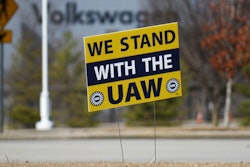
 Matt Hall, Vice President, Enterprise and Education Sales and Services at Rosetta Stone
Matt Hall, Vice President, Enterprise and Education Sales and Services at Rosetta StoneCurrently, there are more than 251,000 manufacturing firms, employing over 24 million immigrant employees in the United States, making manufacturing one of the largest employing industries with one of the most diverse workforces.
A culturally charged work environment is an ideal atmosphere to bring a melting pot of individuals together. It creates an increase in creativity, as employees from different backgrounds can bring in a vast array of solutions on how to achieve a common goal, and a positive reputation, as job seekers are often drawn to companies with diverse workforces that make it evident they do not practice employment discrimination. But along with these benefits, new issues may arise that make it more difficult to get the job done efficiently and safely.
The Migration Policy Institute estimates that approximately 10 percent of the eligible working population (18-64 years old) in the U.S. lack competent English language skills, and according to a report from Brookings Institute, the majority of the growth in the U.S. labor force over the next four decades is projected to come from immigrants and their children. Given how critical workplace safety and communication are in the manufacturing industry, it’s imperative that language skills gaps are addressed to ensure productivity and safety are not negatively impacted. In a recently released whitepaper by Rosetta Stone titled “Why Manufacturing Cannot Forgo English Language Training,” such growth is described as a “double-edged sword for manufacturers.”
The lack of English proficiency poses a problem for the manufacturing industry in particular due to the high-risk nature of the field and there being little room for error. When communication between employees gets lost in translation, what’s intended to be clear directions dissolve, making injuries more likely to occur because of misunderstandings.
The issues at hand are equally frustrating and detrimental for LEP workers as a lack of English skills decreases their efficiency and effectiveness, with them often making more mistakes as a result of language barriers getting in the way of their training. According to a survey from the National Association of Manufacturers, LEP is the primary challenge in maintaining and advancing immigrant employees in manufacturing firms.
 (AP Photo)
(AP Photo)Due to a lack of understanding, LEP employees are more likely to violate Occupational Safety and Health Administration (OSHA) regulations and have on-the-job accidents. In fact, problems associated with communicating hazards to workers was cited as one of OSHA’s Top 10 most frequent violations in 2015, while researchers at the University of Southern California found that male Latino immigrants “have the highest average workplace injury rate at 13.7 per 1,000 workers.”
Given these statistics, it’s clear that there is a gap in the industry, and it’s crucial for employers to provide LEP employees with the tools needed to effectively communicate in the work place to eliminate dangerous situations.
There is no doubt that manufacturing firms would see the inherent value of investing in comprehensive language training for their employees. Some benefits, for example, include:
- The risk of incurring OSHA violations and penalties would be dramatically slashed as workers proficient in English would easily contribute to safer working conditions.
- Work environments would become more conducive and harmonious.
- Workers who clearly understand and communicate with each other are more likely to pull together cohesively as a team.
Additionally, firms that choose to invest in language training would be leaders in the manufacturing sector when it comes to labor relations. According to the National Association of Manufacturers, representing the interests of workers increasingly means negotiating contracts that include English language training in the workplace.
As with any new initiative, comprehensive language training requires an upfront commitment of time and money by the manufacturers. There’s no question that it will take time for workers to sharpen their language skills and additional funds to set up the program, but what you put in, you get out. If manufacturers provide their employees with the specific tools they need to succeed, there’s a much higher chance they’ll do just that.
Matt Hall has a strong background in international sales, new business development, team building, account management, contract negotiation, strategic planning and client satisfaction. Since joining Rosetta Stone in October 2012, Matt and his team have been responsible for turning a declining K-12 business into a growth engine for the Enterprise and Education business and are now focused on building a similar structure and culture within the Enterprise and International markets.
A graduate of Central Washington University, Matt's 17 year career spans a variety of management roles at organizations including a startup (Serials Solutions) later sold to ProQuest, ProQuest and Aerotek. He is based out of Seattle, WA.






















